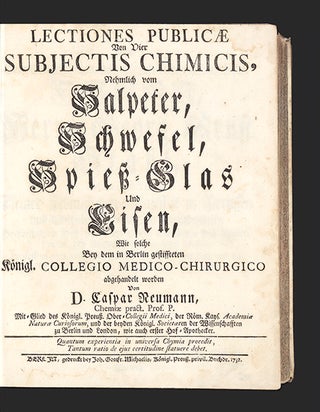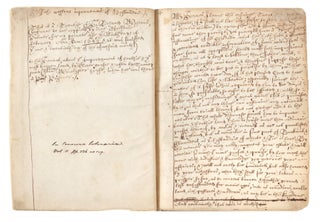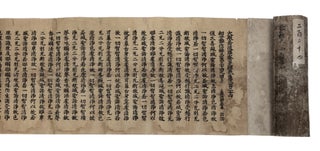The Landmarks of Sendai
SENDAI KANOKO [The Fawn in Sendai].
Manuscript on paper with one map, 14 full-page, & about 20 smaller illus., finely drawn in brush & various colors. 53 folding leaves. 8vo (295 x 195 mm.), orig. blue wrappers (rubbed & a little worn), manuscript label on upper cover with “Sendai Kanoko” written, new stitching. [Japan]: from final page (in trans.) “copied 1839.”
The earliest survey of the wealthy Sendai fiefdom — known as the Sendai Kanoko — was prepared in 1695. At that time, the domain was led by Tsunamura Date (1659-1719). The survey was part of a nation-wide effort in the Genroku era to increase the amount of new farmland and improve irrigation works. When Tsunamura finally was able to exercise his own authority (following the famous succession feud Date Sodo), he ordered a series of public-works projects including building windbreaks and improving flood controls and irrigation. He also sponsored the construction of numerous Buddhist temples and Shinto shrines.
Many of his efforts were incorporated into the Sendai Kanoko, which first appeared in 1695 in manuscript. Copies were made over the following decades and centuries, and it was finally published in an unillustrated 1899 edition.
The text begins with a history of the Sendai region, followed by a pasted-in double-page map of the castle and surrounding city of Sendai, which includes some of the notable religious landmarks. Next are descriptions of Kinoshita, Tsutsujigaoka, and Aobayama, nearby gardens Tsunamura built for his citizens, with a series of fine and colorful illustrations of the main features of these places, especially waterfalls and rushing streams with water of great purity. There is also an illustration of a structure designed to capture wolves, suggesting the region had excellent hunting.
The text then continues with a series of local histories of each part of the region: Kawachi, Yahatado, Komegafukuro, Daicho, Shinkoji, Kouchinuma, Onchabatake, Yachi, Hachizuka, Odawara, Hachiya, and others. Following this is a series of fine illustrations of the various buildings of the Yahata shrine.
The next section of the manuscript lists the district judicial courts of the region with the number of judges (Kendan) and the number of local village leaders (Kimoiri). This is followed by illustrations of two Seisatsu, public structures built to display kosatsu (boards upon which regulations, edicts, and notices were written). There are three boards mounted on the first Seisatsu, including a Kirishitan Kosatsu, which demanded that all Christians be turned in to the local government. The following pages give the texts of the three boards (the second deals with ethical behavior, filial piety, loyalty to the governing lord, and the third with regulations regarding the treatment of horses). The second Seisatsu depicts four boards, one of which deals with express deliveries (akin to our pony express). Another board contains regulations regarding fraudulent products.
There are references to Basho Matsuo and some of the sights he visited in his masterwork Oku no Hosomichi [The Narrow Road to the Deep North]. There is also an important section on the Korean mission’s visit to Sendai in July 1663.
The next section lists temples of the region, their sects, and brief histories, accompanied by a series of charming illustrations of the Yakushido shrine buildings and gate, the Atago jinja shrine’s structures, the Yahata daijin shrine, the Issan jinja shrine and its numerous buildings, the Toshogu shrine in Nikko (with an account of Tsunamura’s involvement in the repair of the shrine in 1689-90), Shakado (Tsunamura’s mausoleum for his late mother), and Tenmangu. Many of these buildings were constructed by Tsunamura’s ancestor Masamune Date (1567-1636), who was responsible for making Sendai an important domain.
The rather poetic title suggests the purity of the region’s water would attract fawns to drink.
The final page contains an inscription by the 1839 scribe, whose pen name is “Shogetsudo doshuo [or toshuo].”
In fine condition, preserved in a chitsu. The first six leaves have a stain on the upper portion. There is a smallish wormhole in the final 11 leaves.
❧ Sansom, A History of Japan 1615-1867, pp. 63-67 & 158.
Price: $13,500.00
Item ID: 7350

![Item ID: 7350 SENDAI KANOKO [The Fawn in Sendai]. SENDAI KANOKO.](https://jonathanahill.cdn.bibliopolis.com/pictures/7350.jpg?width=768&height=1000&fit=bounds&auto=webp&v=1603900625)
![SENDAI KANOKO [The Fawn in Sendai].](https://jonathanahill.cdn.bibliopolis.com/pictures/7350_2.jpg?width=320&height=427&fit=bounds&auto=webp&v=1603900625)
![SENDAI KANOKO [The Fawn in Sendai].](https://jonathanahill.cdn.bibliopolis.com/pictures/7350_3.jpg?width=320&height=427&fit=bounds&auto=webp&v=1603900625)
![SENDAI KANOKO [The Fawn in Sendai].](https://jonathanahill.cdn.bibliopolis.com/pictures/7350_4.jpg?width=320&height=427&fit=bounds&auto=webp&v=1603900625)
![SENDAI KANOKO [The Fawn in Sendai].](https://jonathanahill.cdn.bibliopolis.com/pictures/7350_5.jpg?width=320&height=427&fit=bounds&auto=webp&v=1603900625)
![SENDAI KANOKO [The Fawn in Sendai].](https://jonathanahill.cdn.bibliopolis.com/pictures/7350_6.jpg?width=320&height=427&fit=bounds&auto=webp&v=1603900625)



